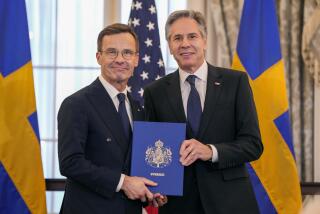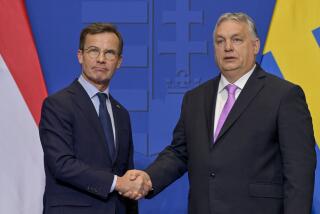Finland: Hinge Between Geopolitical Blocs : Diplomacy: Baltic state could give Eastern Europe lessons on maintaining neutrality.
- Share via
HELSINKI, Finland — The Finns, who have kept the Soviet bear at bay for more than four decades with their peculiar brand of neutrality, may have written the book on foreign policy for their Eastern European neighbors who have broken free of Moscow’s embrace.
“What could be useful to them in our experience is the kind of confidence-building that has taken place between Finland and the Soviet Union,” Aarni Karhilo, an undersecretary of state and Finland’s former ambassador to Moscow, commented this week. “It was a slow process, but both sides realized there were common interests, and this ultimately led to stability.”
The U.S.-Soviet summit to be held here today will highlight the unique status of Finland as a longtime hinge between the geopolitical blocs. A country with a determinedly Western-facing, capitalist economy, Finland is nevertheless bound to the Kremlin by a 1948 Treaty of Friendship, still active, that obligates it to fight Germany or a German ally should they invade to strike at the Soviet Union.
This singular postwar arrangement, the outgrowth of Finland’s defeat by the Red Army in the 1939-40 Winter War and a separate campaign against the Soviets in World War II, was long sneered at in the West. It spawned the term Finlandization, meaning supine submission to Soviet domination under the guise of neutrality.
That the Finns have been acutely sensitive to the feelings of their great neighbor to the east is beyond question. In 1958, for example, a Finnish Communist named Laino who had been interior minister was about to publish his memoirs, documenting meddling by the Soviet Communists in their Finnish comrades’ affairs.
However, Finland’s prime minister, alarmed about possibly provoking Moscow’s ire with such revelations, asked the publisher not to distribute the book, and it never got beyond the warehouse.
Even Marshal Carl Gustav Mannerheim, Finland’s brilliant generalissimo during the Winter War, believed that independence could be strengthened if his country could show the masters of the Kremlin that Finland would respect their security needs. Such an approach became the anchor of Finland’s postwar policy.
Although the Finns, ever prudent, refrain from drawing parallels between their country and the erstwhile East Bloc satellites, the challenge that governments from Prague to Sofia face is now similar: To find the proper blend of independent foreign and domestic policies while assuring the Soviet Union that despite the disintegration of the Warsaw Pact, Moscow’s legitimate security interests will not be imperiled.
For the men and women who have sat in Helsinki’s gray granite parliament building, finding the right mix was sometimes painful, especially in the less tolerant years in Soviet diplomacy that preceded President Mikhail S. Gorbachev’s coming to power.
Though devastated by World War II and scarred by the loss of about 85,000 men in combat, for instance, Finland reluctantly turned down the U.S. invitation to join the Marshall Plan to avoid arousing the suspicions of Soviet dictator Josef Stalin.
“The Marshall Plan was designed to save Europe from communism, but Finland may have saved herself from communism by saying no to the Marshall Plan,” Max Jakobson, one of this country’s leading experts on international affairs, has observed.
In fact, it was only last year that Finland dared become a full-fledged member of the Council of Europe, which had long been considered by the Kremlin to be a club run by its class enemy, the wealthy Western bourgeoisie. Joining the Common Market trade bloc, however, is still considered out of the question, although another professed neutral, Ireland, already belongs.
“The difference is that Ireland is not located on the fault line between East and West, where Finland is,” noted a Scandinavian diplomat who specializes in Finnish affairs.
However, as the new membership in the Council of Europe shows, there is a course change in Finnish policy to take advantage of the new opportunities under Gorbachev, although it sometimes seems to move no faster than a glacier.
When Gorbachev, during his last visit to Helsinki in October, declared, “I would like to greet a neutral Finland,” that formula, much more straightforward than anything the Soviets had told the Finns during the preceding two decades, was taken as proof that the Kremlin had acknowledged Finland’s right to an independent foreign policy.
With the world moving beyond the East-West schism, Finland will have more freedom of action and “be drawn much more closely into international affairs,” President Mauno Koivisto said this week. He went on to prove his point by using uncommonly harsh language to condemn Iraq for its invasion of Kuwait.
In a key speech on European integration, Foreign Minister Pertti Paasio also ruffled diplomatic feathers here recently by not mentioning either the Soviet Union or the 1948 Soviet-Finnish Friendship Treaty, as had long been Finnish protocol.
With foreign policy no longer a zero-sum game for the superpowers, the Finns do not have to worry that by siding with the Americans, for example against Iraqi aggression, they will automatically be arrayed against Moscow. But their time-tested commitment to neutrality, plus their attentiveness to the superpower on their doorstep, will remain.
After all, Finns have a saying, proven by many bitter episodes in their country’s past: “No matter how weak Russia might become, it will always be big and strong enough for us.”
More to Read
Sign up for Essential California
The most important California stories and recommendations in your inbox every morning.
You may occasionally receive promotional content from the Los Angeles Times.













